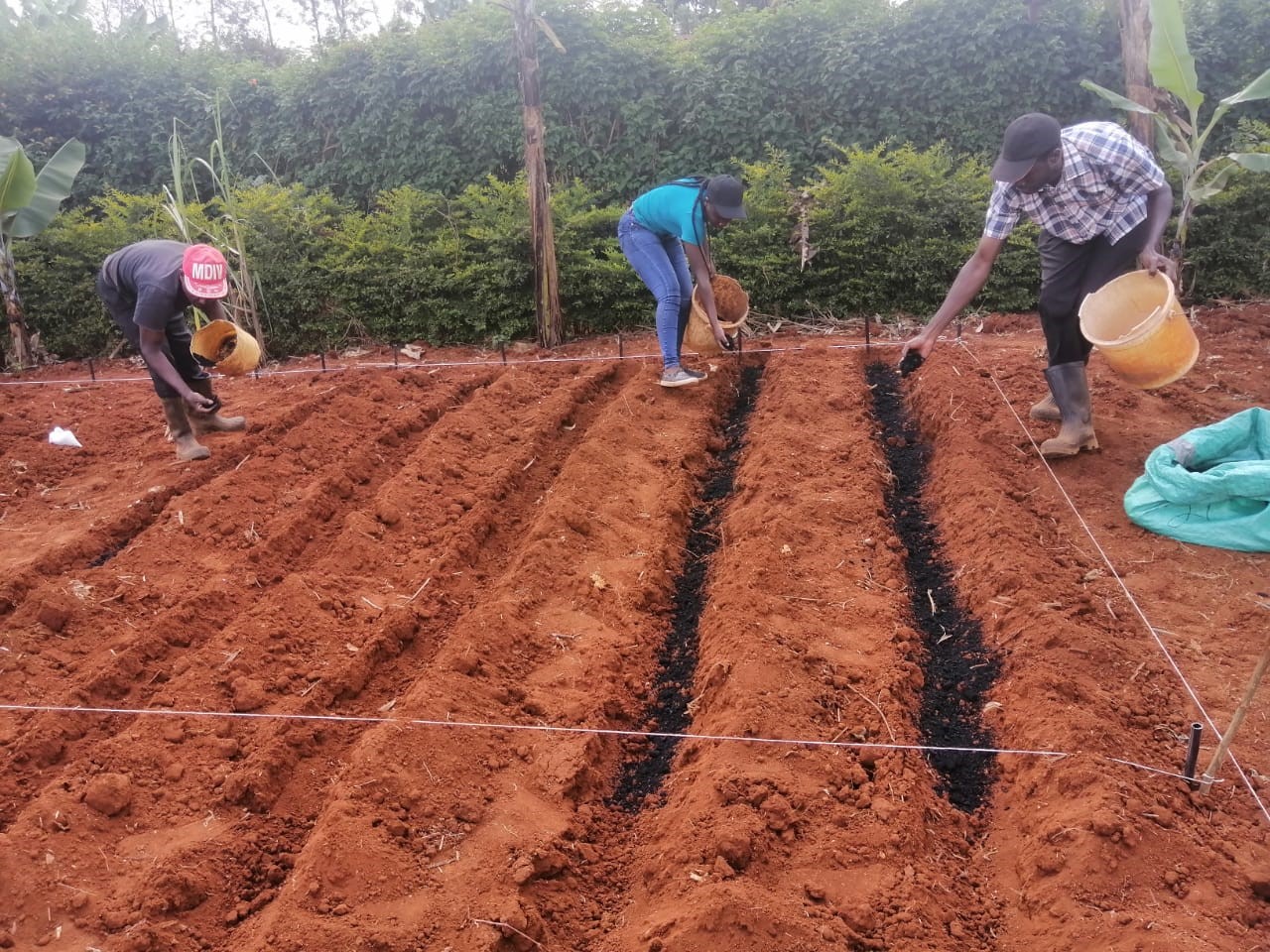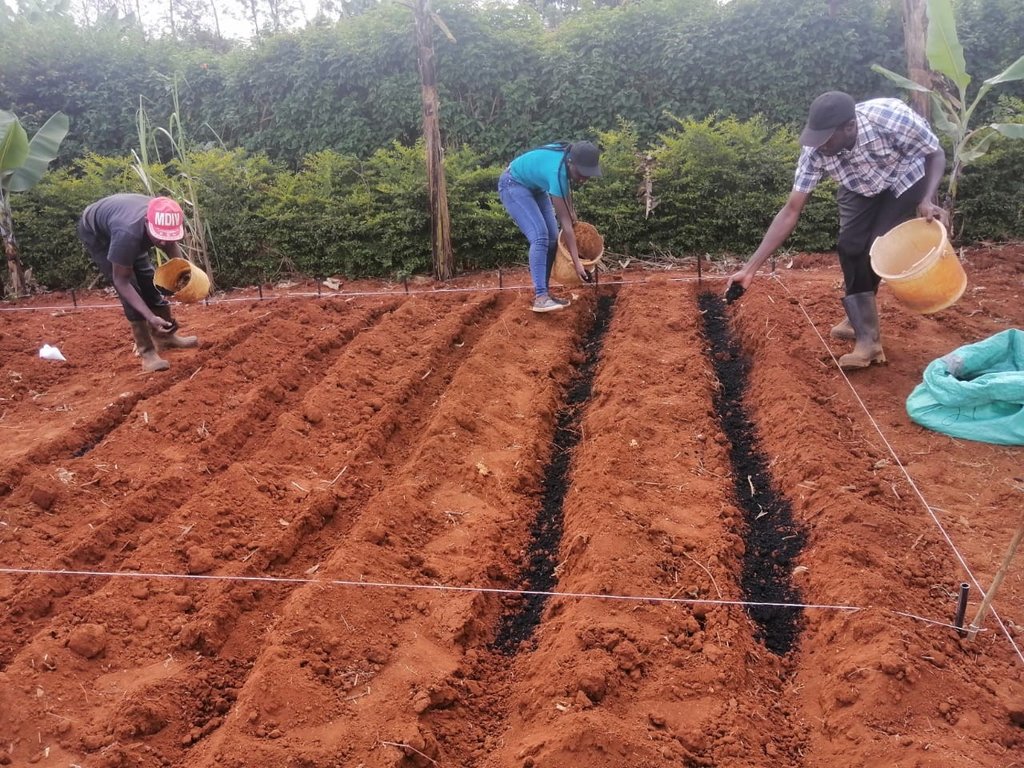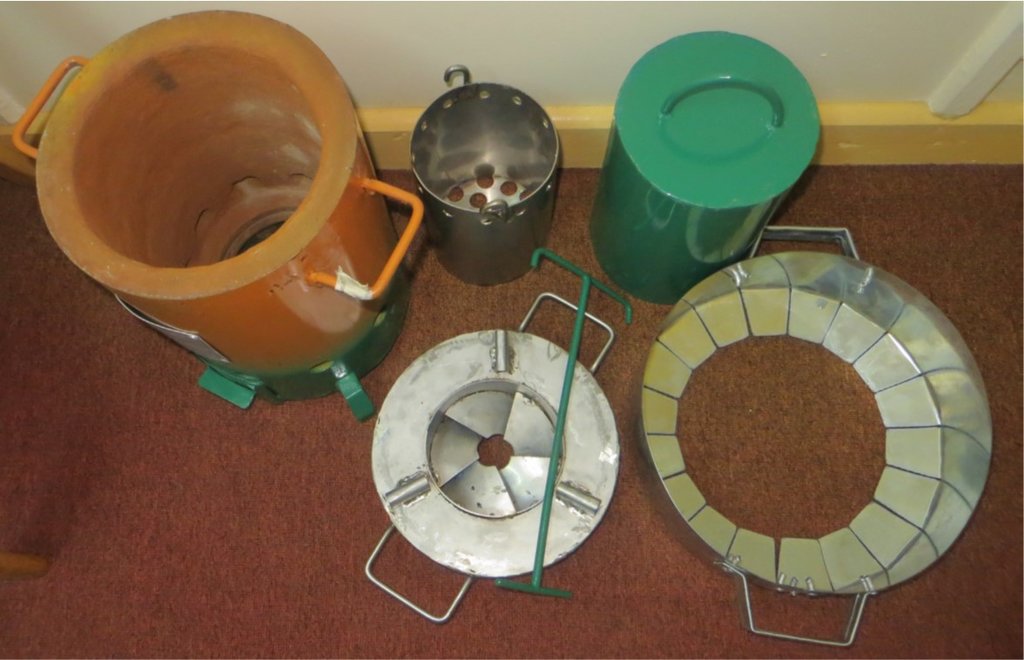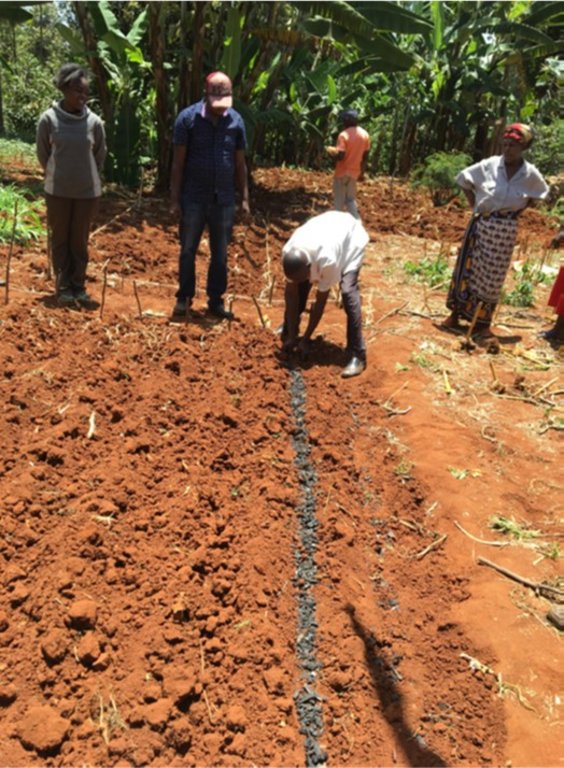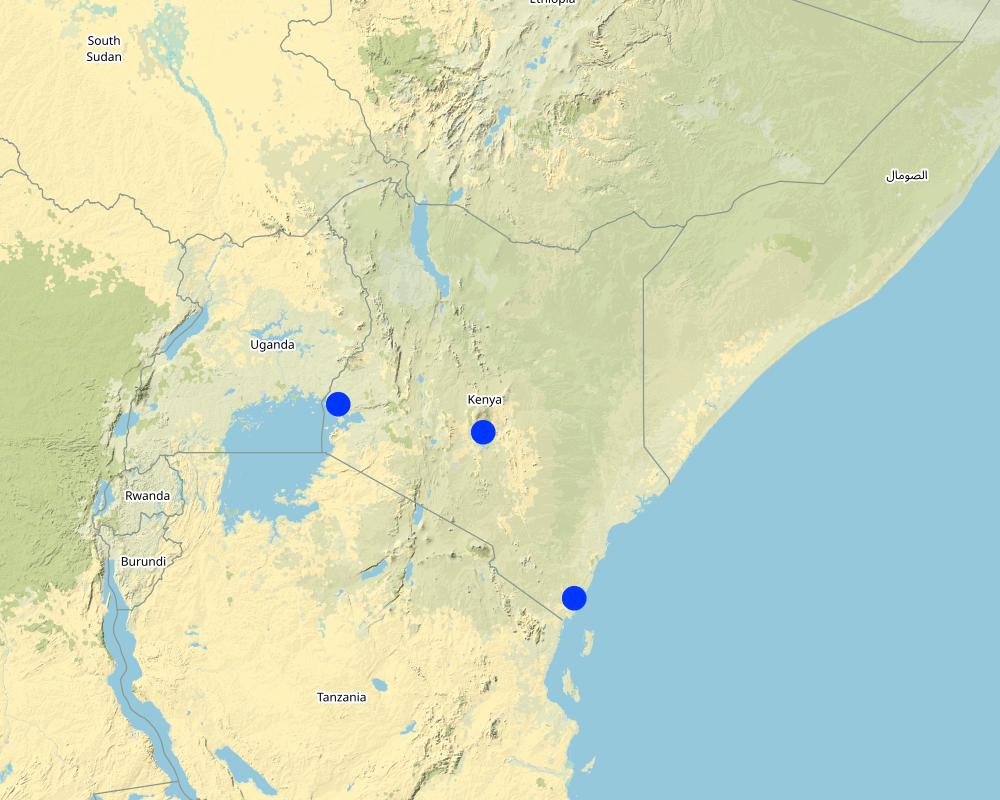Biochar application by smallholder farmers [肯尼亚]
- 创建:
- 更新:
- 编制者: Niels Thevs
- 编辑者: Dries Roobroeck
- 审查者: William Critchley, Rima Mekdaschi Studer
technologies_6349 - 肯尼亚
查看章节
全部展开 全部收起1. 一般信息
1.2 参与该技术评估和文件编制的资源人员和机构的联系方式
co-compiler:
co-compiler:
Roebroock Dries
IITA
肯尼亚
有助于对技术进行记录/评估的机构名称(如相关)
Deutsche Gesellschaft für Internationale Zusammenarbeit (GIZ) GmbH (GIZ) - 德国1.3 关于使用通过WOCAT记录的数据的条件
编制者和关键资源人员接受有关使用通过WOCAT记录数据的条件。:
是
1.4 所述技术的可持续性声明
这里所描述的技术在土地退化方面是否存在问题,导致无法被认为是一种可持续的土地管理技术?:
否
2. SLM技术的说明
2.1 技术简介
技术定义:
Application of biochar to soils in the tropics / sub-tropics improves their ability to store and supply nutrients and water for crop growth, thereby enhancing yields and food security. At the same time, biochar holds carbon in soils for extended time periods, which makes it an agricultural practice that contributes to climate change mitigation.
2.2 技术的详细说明
说明:
Biochar is carbonised organic material that is produced through pyrolysis, that is thermal conversion under low or no oxygen. The biochar is used as an amendment to farmland for ameliorating soil properties. Owing to the great number of micropores and charges on biochar, its application to soil boosts water and nutrient storage, and their delivery to crops. Biochar also helps neutralise acidity in soils, replacing the need for lime. All these positive effects make it ideally suited for acid, nutrient-poor soils in tropical/ sub-tropical regions. Even at low rates of 1 or 2 tonnes per hectare, biochar significantly increases crop production. Biochar hardly decomposes in soils, causing positive effects to last for several years without repeat application. This also provides very stable carbon storage on farms which helps mitigate climate change. Its stability also allows farmers to gradually add biochar to the entire farm, thereby increasing their food self-sufficiency and incomes.
Biochar itself is not a fertilizer, but a soil rejuvenating agent. Therefore, farmers must apply essential nutrients through synthetic or organic inputs to reap the full yield potential and maintain soil fertility. Yet, when biochar is combined with fertilizers, about 40% - 70% nitrogen and phosphorus can be saved over multiple seasons while maintaining the same productivity. Biochar is a promising solution to address low response of crops to fertilizer addition in tropical soils and to alleviate the impact of input price hikes and supply disruptions.
In the study presented here, farmers produced biochar as a residue from small gasifier stoves during daily cooking. These systems are highly energy efficient and reduce the consumption of firewood while improving indoor air quality, which, alongside crop yield gains from biochar, is perceived positively by farmers. The specific design of gasifier stoves requires them to be well-packed with appropriately sized tree prunings or maize stems. For larger meals it requires a refill, which users find less convenient than their traditional open combustion fires. Life-cycle assessment shows that households significantly reduce greenhouse gas emissions with the gasifier stoves when biochar is applied to the farm. For the field trials with maize and kale in this study, farmers applied their usual rates of inorganic fertilizers, animal manure, or a combination of both. Results from this multi-locational participatory assessment showed that maize grain yield increased by 0.2 - 0.7 tonnes per hectare for every tonne of home-made biochar that was added to the field.
One household can produce 300 kg biochar per year by cooking on the gasifier stove. With this amount a biochar dosage of 1.5 t/ha can be realized on an area of 0.2 ha per year. If biochar is not spread evenly, but along seed rows, its effective dosage can be increased. As the gasifier stove can be operated for 2-3 years, it is assumed that the costs of 50 USD, which are needed to purchase one gasifier, are good to equip 1 ha of land with an amount of biochar that results in increased crop yields.
2.3 技术照片
关于照片的一般说明:
Both photographs were taken from the publication: Njenga M, Sundberg C, Gitau JK, Mahmoud Y, Röing de Nowina K, Mendum R and Karltun E 2020. Biochar stoves for socio-ecological resilience: Lessons from small-scale farms in rural Kenya. Policy Brief No 51. Nairobi, Kenya. World Agroforestry (ICRAF)
2.5 已应用该技术的、本评估所涵盖的国家/地区/地点
国家:
肯尼亚
区域/州/省:
Embu County, Kwale County, Siaya County
具体说明该技术的分布:
- 适用于特定场所/集中在较小区域
技术现场是否位于永久保护区?:
否
Map
×2.6 实施日期
注明实施年份:
2016
2.7 技术介绍
详细说明该技术是如何引入的:
- 在实验/研究期间
注释(项目类型等):
IITA (International Institute of Tropical Agriculture) started a long-term field trial in 2006, in which crop and soil properties were monitored following one initial biochar application of 100 t/ha. ICRAF investigated the charcoal value chain in Kenya and, among others, promoted cooking stoves which were more efficient than the traditionally used open fires. Those stoves run on pyrolysis, which provides heat for cooking and charcoal as a residual. That charcoal can be used for cooking so that the initial biomass is used more efficiently as an energy source. Or, alternatively, the residual charcoal is used as biochar to improve the farmers' soils.
This combination of cooking and biochar production and application to soils began in 2016 as participatory research.
3. SLM技术的分类
3.1 该技术的主要目的
- 改良生产
- 适应气候变化/极端天气及其影响
- 减缓气候变化及其影响
- 创造有益的经济影响
- 创造有益的社会影响
3.2 应用该技术的当前土地利用类型
同一土地单元内混合使用的土地::
否

农田
- 一年一作
年作 - 具体指明作物:
- 谷物类 - 玉米
- 蔬菜 - 叶菜(色拉、卷心菜、菠菜和其他)
每年的生长季节数:
- 2
具体说明:
2 seasons in Embu and Siaya, 1 season in Kwale
采用间作制度了吗?:
是
如果是,说明哪些作物是间作的:
Part of the households intercrop maize with beans.
采用轮作制度了吗?:
否
3.3 由于技术的实施,土地使用是否发生了变化?
由于技术的实施,土地使用是否发生了变化?:
- 否(继续问题3.4)

农田
- 一年一作
年作 - 具体指明作物:
- 谷物类 - 玉米
采用间作制度了吗?:
是
如果是,说明哪些作物是间作的:
maize and beans
采用轮作制度了吗?:
否
3.4 供水
该技术所应用土地的供水:
- 雨养
3.5 该技术所属的SLM组
- 土壤肥力综合管理
3.6 包含该技术的可持续土地管理措施

农艺措施
- A2:有机质/土壤肥力
3.7 该技术强调的主要土地退化类型

化学性土壤退化
- Cn:肥力下降和有机质含量下降(非侵蚀所致)
- Ca:酸化

物理性土壤退化
- Pc:压实
- Pi:覆土
注释:
Biochar increases the cation exchange capacity of soils and enhances the plant availability of phosphorus so that it contributes to soil fertility. Biochar increases the soil pH so that it treats acidification of soils. In the field of soil physical properties, biochar decreases the bulk density of soils and adds pore space to soils so that the infiltration into the soil and the usable field capacity of soils are increased. In this specific case, soil sealing and compaction do not play a role, but biochar can address those soil degradation issues.
3.8 防止、减少或恢复土地退化
具体数量名该技术与土地退化有关的目标:
- 减少土地退化
- 修复/恢复严重退化的土地
4. 技术规范、实施活动、投入和成本
4.2 有关投入和成本计算的一般信息
具体说明成本和投入是如何计算的:
- 每个技术单元
指定单位:
one gasifier cooking stove and the resulting amount of biochar
具体说明成本计算所用货币:
- 美元
4.3 技术建立活动
| 活动 | 时间(季度) | |
|---|---|---|
| 1. | Biochar production | Year-round while using the gasifier cooking stove. |
| 2. | Mixing biochar into the soil | During the normal time of field preparation for and planting of the next crop |
| 3. | Proceed with normal cropping activities |
注释:
This SLM technique adds biochar to the ongoing cropping activities. So, the choice of crops, soil preparation, planting, inputs, and harvest do not change after biochar application. The biochar is sourced from so-called gasifier cooking stoves, which are stoves that perform through pyrolysis. The excess energy of that pyrolysis is used for cooking, while the residual char is applied as biochar to the farmers' field. Char (biochar) is produced during every cooking activity, collected, and finally applied. Most household in the project regions use open three-stone fires for cooking followed by charcoal. Adoption of the gasifier stoves is a shift away from the open fires and charcoal.
4.4 技术建立所需要的费用和投入
| 对投入进行具体说明 | 单位 | 数量 | 单位成本 | 每项投入的总成本 | 土地使用者承担的成本% | |
|---|---|---|---|---|---|---|
| 劳动力 | gasifier cooking stove | 1.0 | 50.0 | 50.0 | ||
| 技术建立所需总成本 | 50.0 | |||||
| 技术建立总成本,美元 | 50.0 | |||||
注释:
As costs we only listed the 50 USD per gasifier cooking stove. As the other farm operations do not change, no further costs for plant materials or fertilizers or other were listed, because those inputs do not change solely due to the use of biochar from the gasifier stoves.
One household can produce 300 kg biochar per year by cooking on the gasifier stove. With this amount a biochar dosage of 1.5 t/ha can be realized on an area of 0.2 ha per year. If biochar is not spread evenly, but along seed rows, its effective dosage can be increased. As the gasifier stove can be operated for 2-3 years, it is assumed that the costs of 50 USD are good to equip 1 ha of land with an amount of biochar that results in increased crop yields.
4.5 维护/经常性活动
| 活动 | 时间/频率 | |
|---|---|---|
| 1. | Replace the gasifier cooking stove | every three years |
注释:
Once biochar has been applied into a given soil, it sits there in the soil and does not require further maintenance. The farming activities and their associated labor remain unchanged compared to the the time before biochar application.
4.6 维护/经常性活动所需要的费用和投入(每年)
| 对投入进行具体说明 | 单位 | 数量 | 单位成本 | 每项投入的总成本 | 土地使用者承担的成本% | |
|---|---|---|---|---|---|---|
| 设备 | gasifier cooking stove | 1 | 0.33 | 50.0 | 16.5 | 100.0 |
| 技术维护所需总成本 | 16.5 | |||||
| 技术维护总成本,美元 | 16.5 | |||||
注释:
The depreciation of the gasifier cooking stove and the need to replace it every three years is included here unde rrecurrent costs.
4.7 影响成本的最重要因素
描述影响成本的最决定性因素:
Purchase price of the gasifier stove. Opportunity cost for collection and pre-processing of tree prunings and crop residues for the stove.
5. 自然和人文环境
5.1 气候
年降雨量
- < 250毫米
- 251-500毫米
- 501-750毫米
- 751-1,000毫米
- 1,001-1,500毫米
- 1,501-2,000毫米
- 2,001-3,000毫米
- 3,001-4,000毫米
- > 4,000毫米
有关降雨的规范/注释:
Embu: 1200 mm, Siaya: 1350 mm, Kwale 1050 mm
农业气候带
- 半湿润
5.2 地形
平均坡度:
- 水平(0-2%)
- 缓降(3-5%)
- 平缓(6-10%)
- 滚坡(11-15%)
- 崎岖(16-30%)
- 陡峭(31-60%)
- 非常陡峭(>60%)
地形:
- 高原/平原
- 山脊
- 山坡
- 山地斜坡
- 麓坡
- 谷底
垂直分布带:
- 0-100 m a.s.l.
- 101-500 m a.s.l.
- 501-1,000 m a.s.l.
- 1,001-1,500 m a.s.l.
- 1,501-2,000 m a.s.l.
- 2,001-2,500 m a.s.l.
- 2,501-3,000 m a.s.l.
- 3,001-4,000 m a.s.l.
- > 4,000 m a.s.l.
说明该技术是否专门应用于:
- 不相关
关于地形的注释和进一步规范:
Kwale: 328 m a.s.l.
Embu: 1350 m a.s.l.
5.3 土壤
平均土层深度:
- 非常浅(0-20厘米)
- 浅(21-50厘米)
- 中等深度(51-80厘米)
- 深(81-120厘米)
- 非常深(> 120厘米)
土壤质地(表土):
- 中粒(壤土、粉土)
土壤质地(地表以下> 20厘米):
- 中粒(壤土、粉土)
表土有机质:
- 中(1-3%)
如有可能,附上完整的土壤描述或具体说明可用的信息,例如土壤类型、土壤酸碱度、阳离子交换能力、氮、盐度等。:
The following information are available for two field plots out of the three counties:
Embu County: pH(H2O) - 5.01, SOC - 2.01%, sand - 21%, clay - 43.5%
Siaya County: pH(H2O) - 5.25, SOC - 1.56%, sand - 22.4%, clay - 60.1%
5.4 水资源可用性和质量
地表水的可用性:
好
水质(未处理):
不良饮用水(需要处理)
5.6 应用该技术的土地使用者的特征
定栖或游牧:
- 定栖的
生产系统的市场定位:
- 生计(自给)
非农收入:
- 收入的10-50%
相对财富水平:
- 贫瘠
个人或集体:
- 个人/家庭
机械化水平:
- 手工作业
性别:
- 女人
- 男人
说明土地使用者的其他有关特征:
Women and children operate the gasifier stove and therefore produce the biochar. In the field it is mainly men who mix the biochar into the soil and perform other farm operations.
5.7 应用该技术的土地使用者使用的平均土地面积
- < 0.5 公顷
- 0.5-1 公顷
- 1-2 公顷
- 2-5公顷
- 5-15公顷
- 15-50公顷
- 50-100公顷
- 100-500公顷
- 500-1,000公顷
- 1,000-10,000公顷
- > 10,000公顷
这被认为是小规模、中规模还是大规模的(参照当地实际情况)?:
- 小规模的
注释:
0.5 - 2 ha
5.8 土地所有权、土地使用权和水使用权
土地所有权:
- 个人,未命名
- 个人,有命名
土地使用权:
- 个人
用水权:
- 自由进入(无组织)
土地使用权是否基于传统的法律制度?:
是
5.9 进入服务和基础设施的通道
健康:
- 贫瘠
- 适度的
- 好
教育:
- 贫瘠
- 适度的
- 好
技术援助:
- 贫瘠
- 适度的
- 好
就业(例如非农):
- 贫瘠
- 适度的
- 好
市场:
- 贫瘠
- 适度的
- 好
能源:
- 贫瘠
- 适度的
- 好
道路和交通:
- 贫瘠
- 适度的
- 好
饮用水和卫生设施:
- 贫瘠
- 适度的
- 好
金融服务:
- 贫瘠
- 适度的
- 好
6. 影响和结论性说明
6.1 该技术的现场影响
社会经济效应
生产
作物生产
SLM之前的数量:
0,9 Mg/ha
SLM之后的数量:
4.4 Mg/ha
注释/具体说明:
- Range of maize: from 0,9 Mg/ha (control) to 4.4 Mg/ha (biochar plot) and average increase of 33% in kale yields (on 68% of the farms) in experiment where farmers used their own biochar.
- in longterm experiment with higher amounts of biochar a yield increase of 84% was observed
-
收入和成本
收入来源的多样性
注释/具体说明:
20-40% of firewood could be saved by using the biochar gasifiers instead of traditional cooking stoves. This reduces costs and work load for households.
生态影响
减少气候和灾害风险
碳和温室气体的排放
注释/具体说明:
54 to 100% plus net carbon sequestration.
6.2 该技术的场外影响已经显现
温室气体的影响
注释/具体说明:
Due to reduced demand for fuel wood, this SLM technology reduces forest degradation and associated greenhouse gas emissions.
6.4 成本效益分析
技术收益与技术建立成本相比如何(从土地使用者的角度看)?
短期回报:
积极
长期回报:
积极
技术收益与技术维护成本/经常性成本相比如何(从土地使用者的角度看)?
短期回报:
积极
长期回报:
积极
注释:
The main benefits from this SLM technology from the land users' perspective are increased crop yields, reduced need to collect fuel wood, and improved indoor ambient air quality. The latter two benefits materialize immediately, onec the gasifier is used. The crop yields increase during the season that follows the biochar application, which is a short-term benefit. These benefits justify the establishment costs, which in fact are the costs to purchase the gasifier.
On a long-term perspective, the effect to improve the soil, which leads to crop yield increases, remains, because biochar is stable in soils ove rlong time periods. Particularly positive is that there are no maintenence costs to keep the biochar in the soil.
6.5 技术采用
- 单例/实验
在所有采用这项技术的人当中,有多少人是自发的,即未获得任何物质奖励/付款?:
- 0-10%
6.6 适应
最近是否对该技术进行了修改以适应不断变化的条件?:
否
6.7 该技术的优点/长处/机会
| 土地使用者眼中的长处/优势/机会 |
|---|
| Most land users stated to have observed positive impacts on soil health and improvement of soil fertility. Additionally, about 25% of the land users specifically mentioned that the moisture retention in the soil improved after biochar application. Some land users experienced lower costs for fertilizers. |
|
Most land users found the small top-lit updraft cooking stoves are easy to use, though being more suitable for food with short cooking time. All land users stated that the gasifier cooking stoves were cleaner than the traditional open fires and charcoal stoves, since the gasifiers produced less smoke, less soot, and fewer ashes. Some land users responded even that the gasifiers were less harmful to cooking utensils and food tasted better (less smoky). The gasifier stove was preferred by land users because it takes less fuel and therefore saves time to collect fire wood and household expenditures. This was particularly viewed positively by women. The residual char also can be used as an energy source. Some land users saw sales of charcoal as potential additional income. |
| In total, the package of using gasifier stoves for cooking and applying the residual biochar to soils was seen as beneficial by most land users, because it saved costs and efforts on the side of cooking and increased crop yields and income. |
| 编制者或其他关键资源人员认为的长处/优势/机会 |
|---|
|
Biochar improves soil properties which intensifies crop production. Even a small amount of biochar added to the soil has a long-lasting positive effect on yields. The effect of a one-time biochar application lasts for decades. Therefore, if soils are enriched with biochar by repeatedly adding low quantities, its benefits to land users accumulate over time. Biochar increases the cation exchange capacity, pH, and phosphorus availability of soils, which are key constraints to in many farming systems across tropical Africa. Non-responsive soils are turned into soils that respond to fertilizer application. |
6.8 技术的弱点/缺点/风险及其克服方法
| 土地使用者认为的弱点/缺点/风险 | 如何克服它们? |
|---|---|
| Half of the respondents stated the production of biochar was time consuming due to the process of cutting the feedstock in suitable sizes, as needed for the gasifier stove. | Chopped firewood for the gasifier could become a source of income for youth. |
| 编制者或其他关键资源人员认为的弱点/缺点/风险 | 如何克服它们? |
|---|---|
| Gasifiers may emit more methane than technologically more advanced pyrolysis units. |
Improve the gasifier utility with a shift to the latest mobile or decentralized technologies that produce syngas, green hydrogen or electricity that can be used for cooking. |
| Deploying gasifier and biochar at large scale without regulations poses a risk of unsustainable rates of tree clearing and residue removal. | Follow rules such as EBC and only use on-farm or residual biomass. |
7. 参考和链接
7.1 信息的方法/来源
- 实地考察、实地调查
Field surveys took place within different research works, which were published in peer-reviewed papers.
- 与土地使用者的访谈
Interviews with land users took place within different research works, which were published in peer-reviewed papers.
- 根据报告和其他现有文档进行编译
The information was compiled from peer-reviewed papers and exchange with the authors of those papers.
注释:
The study was conducted between 2013 and 2019 and results of different work streams were published in a number of peer-reviewed papers.
7.2 参考可用出版物
标题、作者、年份、ISBN:
Biochar from cooking stoves reduces greenhouse gas emissions from smallholder farms in Africa; Sundberg et al., 2020
可以从哪里获得?成本如何?
https://link.springer.com/article/10.1007/s11027-020-09920-7, open access
标题、作者、年份、ISBN:
Use of Biochar-Producing Gasifier Cookstove Improves Energy Use Efficiency and Indoor Air Quality in Rural Households; Gitau et al., 2019
可以从哪里获得?成本如何?
https://www.mdpi.com/1996-1073/12/22/4285, open access
标题、作者、年份、ISBN:
Implications on Livelihoods and the Environment of Uptake of Gasifier Cook Stoves among Kenya’s Rural Households; Gitau et al., 2019
可以从哪里获得?成本如何?
https://www.mdpi.com/2076-3417/9/6/1205/pdf, open access
标题、作者、年份、ISBN:
Factors influencing the adoption of biochar-producing gasifier cookstoves by households in rural Kenya; Gitau et al., 2019
可以从哪里获得?成本如何?
https://www.sciencedirect.com/science/article/pii/S0973082618308913, open access
标题、作者、年份、ISBN:
Soils, sinks, and smallholder farmers: Examining the benefits of biochar energy transitions in Kenya; Mahmood et al., 2021
可以从哪里获得?成本如何?
https://reader.elsevier.com/reader/sd/pii/S2214629621001262?token=D446F30FC8FDAEC80F73AE31BBFEA69E754E2F9EB21A9605CC6D04A2FE0FCD39182848F88AC6D17BF7D12B8EEED7BD9E&originRegion=eu-west-1&originCreation=20210415190025, open access
标题、作者、年份、ISBN:
Gasifier as a cleaner cooking system in rural Kenya; Njenga et al., 2016
可以从哪里获得?成本如何?
https://www.sciencedirect.com/science/article/abs/pii/S0959652616000743?via%3Dihub, access at no costs through limited number of institutions
标题、作者、年份、ISBN:
Biochar addition persistently increased soil fertility and yields in maizesoybean rotations over 10 years in sub-humid regions of Kenya; Kätterer et al., 2019
可以从哪里获得?成本如何?
https://www.sciencedirect.com/science/article/pii/S0378429018318938?via%3Dihub, open access
标题、作者、年份、ISBN:
sMaize grain yield responses to realistic biochar application rates on smallholder farms in Kenya, Kätterer et al., 2022
可以从哪里获得?成本如何?
https://link.springer.com/article/10.1007/s13593-022-00793-5, open access
7.3 链接到网络上的相关信息
标题/说明:
Biochar stoves for socio-ecological resilience: Lessons from small-scale farms in rural Kenya / Report by ICRAF
URL:
http://apps.worldagroforestry.org/downloads/Publications/PDFS/PB20040.pdf
链接和模块
全部展开 全部收起链接
无链接
模块
无模块


